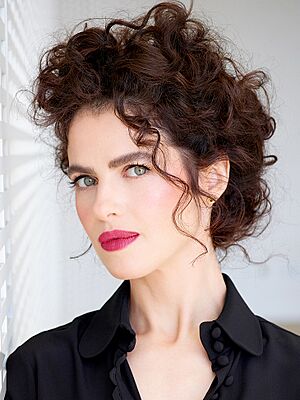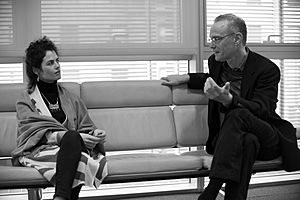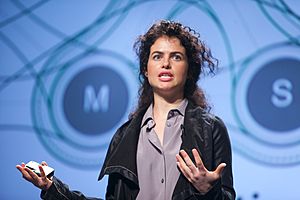Neri Oxman facts for kids
Quick facts for kids
Neri Oxman
|
|
|---|---|
| נרי אוקסמן | |

Oxman in 2017
|
|
| Born | February 6, 1976 Haifa, Israel
|
| Nationality | American, Israeli |
| Education | Hebrew University of Jerusalem Israel Institute of Technology (BA) Architectural Association (MA) Massachusetts Institute of Technology (PhD) |
| Occupation | Designer and academic |
| Spouse(s) |
|
| Children | 1 |
| Parent(s) |
|
| Awards |
|
| Scientific career | |
| Fields | Architectural design |
| Thesis | Material-based design computation (2010) |
| Doctoral advisor | William J. Mitchell |
| Military career | |
| Allegiance | |
| Service/ |
|
| Rank | |
Neri Oxman (born February 6, 1976) is an American-Israeli designer and former professor. She is known for her amazing art and designs that mix different fields. These fields include design, biology, computer science, and how materials are made. She created the term "material ecology" to describe her unique work.
Oxman was a professor at the MIT Media Lab. There, she started and led a research group called Mediated Matter. Her work has been shown in famous museums like the Museum of Modern Art (MoMA) in New York. Other museums, such as Boston's Museum of Science and the Centre Pompidou in Paris, also have her creations in their permanent collections.
Many of Oxman's projects use new ways to create things with 3D printing. She often includes ideas from nature and biology. For example, she has created systems to build structures with silkworms, bees, and ants. She also made a special platform that built structures like Aguahoja from a natural material called chitosan. She even helped create the first 3D printer that can print clear glass. Her other projects include printed clothes, things you can wear, and furniture.
Contents
Early Life and Education
Neri Oxman was born in Haifa, Israel, on February 6, 1976. Her parents, Robert and Rivka Oxman, were both architecture professors. Her sister, Keren Oxman, is an artist. Neri grew up in Israel, spending time in her parents' design studio and at her grandmother's house.
After finishing high school in 1993, she served for three years in the Israeli Air Force. She reached the rank of first lieutenant. After her military service, she studied at Hebrew University's medical school for two years. Then, she decided to switch to architecture. She started her architecture studies at Technion Israel Institute of Technology. She finished her degree at the Architectural Association School of Architecture in London in 2004.
In 2005, Oxman began her PhD studies in architectural design at the Massachusetts Institute of Technology. Her advisor was William J. Mitchell. Her research focused on designing with a deep understanding of materials. She earned her PhD in 2010.
Career Highlights

In 2006, Neri Oxman started a special research project at MIT called material ecology. This project explored new ways to design things using different materials. In 2010, she became a professor at MIT. She was given her own lab, the Mediated Matter group, at the MIT Media Lab. She became a permanent professor at MIT in 2017.
Her research looks at how to design things using computer models and how they fit into their surroundings. This includes new ways to build these designs using different materials. For example, she has worked on creating a "skin" for buildings that can change with the sun to make shade. She also works with materials that can break down naturally. She has published many projects that combine biology, medicine, wearable items, and tools for making things.
Her work has inspired many people to think differently about how materials and structures are designed. In 2016, she helped start the Journal of Design Science. This journal explores ideas that don't fit into just one area of study. Oxman believes that science, engineering, design, and art are all connected. She thinks that what comes from one field can inspire the others.
Oxman's early projects were often surfaces, furniture, or objects that could be worn or displayed. Since 2013, many of her projects have been temporary or interactive art pieces. These often show the process of how they were made and how their materials behave. This includes both mechanical processes, like for Ocean Pavilion and Glass I, and biological ones, like for Silk Pavilion and Synthetic Apiary.
Oxman's work is part of the permanent collections in many museums. These include the Museum of Modern Art (MoMA) in New York and the San Francisco Museum of Modern Art (SFMOMA). Other museums include the Museum of Applied Arts (MAK) in Vienna, the Smithsonian, and Boston's Museum of Fine Arts and Museum of Science. In 2020, MoMA had a special exhibition just for her work.
Oxman is also on the board of the WORLD.MINDS Foundation. Here, she helps with discussions that bring together design, science, and society.
Mediated Matter Research Group
Oxman's Mediated Matter research group uses computer design, digital making, 3D printing, material science, and synthetic biology. They create both large and small structures. The group developed its own ways of making things and special printing machines. They worked with many different 3D production systems. Their projects have ranged from large enclosures and furniture to artwork and clothes. They also worked on biocomposites (materials made from natural and synthetic parts), artificial valves, and even DNA assembly.
Their methods often involve taking pictures of natural samples. Then, they create computer programs to make similar structures. Finally, they develop new ways to build these designs. Projects include wearable clothes and tools, designs powered by the sun and those that break down naturally, new art techniques, and building surfaces, walls, and strong parts for structures.
Building with Nature
The Silk Pavilion, created in 2013, was famous for how it was made. It was woven by 6,500 free-ranging silkworms on a dome-shaped nylon frame. Scientists studied how silkworms would react to different surfaces. They learned what would make the silkworms spin silk onto an existing structure instead of making a cocoon. A robotic arm loosely wove the frame of a large dome from thin nylon threads. This frame was hung in a room. The dome was designed with warmer spots where the silkworms would prefer to spin. Silkworms were released onto the frame in groups. They added layers of silk before being carefully removed. This project combined engineering, sericulture (raising silkworms), and understanding how the sun affected the room. The finished pavilion was hung so people could stand inside it. This idea was used again in 2020 for Silk Pavilion II, which was part of Oxman's exhibition at MoMA.
The Synthetic Apiary, a room-sized project built in 2015, studied how bees behave indoors. It looked at how they built hives in and around different structures. This project was done with a beekeeping company. It was a way to test ideas for helping bee colonies that are struggling. It also explored how natural living spaces could be built into buildings.
Wearable Designs
In 2012, Oxman created a set of body-sized wearable items called Imaginary Beings. These were inspired by legendary creatures. She also worked with fashion designer van Herpen and material scientist W. Craig Carter. Together, they made Anthozoa, a cape and skirt that looked like sea creatures.
In 2015, she designed the Wanderers collection. This collection was inspired by space exploration. It was made with Christoph Bader and Dominik Kolb. The collection included the Living Mushtari chestpiece. This piece was a model of a digestive system filled with tiny living things that could help someone survive in harsh places. This collection was described as "defined by neither time nor place."
In 2016, she made Rottlace, a 3D-printed mask for the singer Björk. It was based on a 3D scan of Björk's face. Björk wore it during the world's first 360° virtual reality live show. Oxman also developed Lazarus, a project designed to capture a person's last breath. She also started working on Vespers, a collection of 15 death masks. These masks were divided into past, present, and future, and had minerals and bacteria inside them.
Environmental Creations
In 2014, she worked with Carter on Gemini. This was a chaise longue (a long chair) with a wooden frame and 3D-printed padding. It was designed to have both strong structure and good sound qualities, creating a calming, womb-like space. It was made using both adding and removing material during printing. The SFMOMA bought this piece the next year. This work led to a model for a larger Gemini Cinema.
New 3D Printing Methods
Mediated Matter also created new machines and tools for printing. These included a printer that could print whole sections of rooms. They also made a glass printer and a fast-drying printer that could make objects stand on their own without needing extra support.
In 2014, they developed G3DP. This was the first 3D printer that could make clear glass. Before this, 3D printers could use glass powder, but the results were weak and not clear. G3DP was a team effort with MIT's Glass Lab and the Wyss Institute. It copied traditional glass-making methods, using a special oven and cooling chamber. This process allowed them to control the color, clearness, thickness, and texture of the glass. Some settings even turned the printer into a "molten glass sewing machine." Two versions of the printer, G3DP and G3DP2, made a collection of glass objects called Glass I and Glass II, which have been shown in exhibits.
A 10-foot tall glass and light sculpture printed by this machine, called YET, was shown at the 2017 Milan Design Week.
Also in 2014, the group created Aguahoja. This project used a water-based printing platform to build structures from chitosan. Chitosan is a natural, water-soluble fiber similar to chitin. They could make strong pillars or long leaves by changing how the fibers were placed. This allowed them to create structures that could be hard in some parts and flexible in others, using the same basic material. This was shown in two art pieces, Aguahoja I and II. These featured a central 15-foot tall sculpture that looked like "enormous, folded cicada wings."
In 2016, the group developed a large robotic printing system called the Digital Construction Platform (DCP). This system printed molds made of polyurethane foam using a robot arm. DCP v2 was able to print a section of a dome that was 15 meters (about 49 feet) across and 4 meters (about 13 feet) high.
Other Innovations
Starting in 2018, the Mediated Matter lab worked on the Totems project. This project explored ways to get melanin (a natural pigment) from different living things and put it into 3D-printed structures. This led to an idea for buildings with outer walls that could react to sunlight. One such idea was a proposed architectural pavilion.
From 2017 to 2020, a new Silk Pavilion was created, called Silk Pavilion II. This project looked at new ways to collect silk from silkworms without needing to boil their cocoons, which ends the silkworm's life.
In 2020, the lab made a new Aguahoja installation, Aguahoja III. It was exactly like the first one but kept in a special climate-controlled gallery. This was done to compare it to the original over a long time. They wanted to see how chitosan breaks down or changes because of the environment. The lab stopped its active work in 2021.
Recent Work
Starting in 2020, Oxman's own studio, Oxman Architects, has continued to explore similar ideas in their projects. They made a documentary about their work called Nature × Humanity. This became the name of a 2022 exhibition of their work at SFMOMA.
In 2020, she created the final version of Silk Pavilion II. She wove a new pavilion in Padua, Italy, working with a silkworm farm nearby. The structure was built on a shape that could dissolve.
In 2021, her team went back to the Synthetic Apiary project. They built a new environment for bees to create hives. This new environment was printed with special scents (pheromones) embedded in it. The resulting hive structures were studied using CT scans. This allowed them to create digital models and learn more about how bees build. They also designed an experiment to test how bees react to low-gravity environments. They built a new type of container to hold this experiment on a Blue Origin suborbital space flight.
Oxman was a design consultant for Francis Ford Coppola's 2024 film Megalopolis. Her work influenced the futuristic city shown in the movie. She also has a small appearance in the film.
Design Philosophy
Neri Oxman's idea of material ecology started in 2006 when she was a student at MIT. It combines 3D printing with biology, engineering, materials science, and computer science. The goal is to create objects and structures that grow naturally, without needing to be put together from separate parts. She suggested creating a material ecology with "whole products" that have different properties and many uses. This means putting humans in harmony with nature, instead of making things on assembly lines where everything is made of separate pieces.
She described her work as changing from "using nature as a resource from the ground to changing it like a biological one." This includes using natural shapes for inspiration, textures, and even for making things. Examples include the glowing bacteria in Mushtari and the silkworms in the Silk Pavilion.
Paola Antonelli, a curator at the Museum of Modern Art, said that Oxman's work helps us "understand nature's many design lessons and turn them into digital forms for future use at all sizes."
Oxman's way of creating shapes and designing for the environment is used by people who make quick prototypes in other fields. She gave a popular TED talk in 2015 about material ecology. In 2019, the Netflix show Abstract: The Art of Design featured her work in its second season.
Personal Life
Neri Oxman is married to investor and hedge fund manager Bill Ackman. They got married in 2019 and have a daughter. They both help manage the Pershing Square Foundation.
Works
Early Works
Oxman's early work focused on 3D printing. This included projects like Carpal Skin, which used a person's pain profile from carpal tunnel syndrome to help ease their discomfort. Another project was Monocoque (2007). This showed how a printed structure could support its own weight using its outer skin instead of inside supports. This needed a printer that could print many different materials at the same time, each with different strengths. She called this "variable property rapid prototyping." In 2008, futurist Bruce Sterling said her work was "amazingly different from anything before." Later, her work involved animals or natural processes to create things.
In 2016, Oxman worked with Björk to create a mask based on the singer's face. She also worked with Dutch fashion designer Iris van Herpen to 3D-print a collection of special clothes.
Selected Works
- Cartesian Wax, Monocoque, Raycounting (2007, MoMA)
- Carpal Skin (2010, Museum of Science)
- Imaginary Beings (2012, Centre Pompidou)
- Silk Pavilion I (2013) and II (2020), installation
- Anthozoa (2013, MFA), couture dress
- Gemini (2015, SF MoMA), acoustical chaise
- Wanderers collection (2015, incl. Living Mushtari)
- Glass I (2014), 3D printer & glasswork
- Rottlace (2016), stage mask
- Aguahoja I & II (2017–2019), biocomposite structures
Images for kids
Selected Exhibits
- SFMOMA, San Francisco: 2022 (Nature × Humanity)
- MoMA, New York: 2007, 2010 (Action: Design over Time), 2015 (This Is for Everyone), 2020 (Neri Oxman: Material Ecology)
- Cooper Hewitt Museum: 2015 (Making Design), 2016 (Beauty)
- Centre Pompidou, Paris: 2012 (Imaginary Beings exhibit, Multiversités Créatives)
- Science Museum, London: 2012 & 2013 (3D PRINT SHOW)
- Museum of Science, Boston: 2012 (Neri Oxman: At the Frontier of Ecological Design)
- Museum of Fine Arts, Boston: 2013, 2016 (#techstyle: Production)
- Museum of Applied Arts, Vienna: 2014 (150 Years of the MAK)
- National Gallery of Victoria, Victoria: 2017 (NGV Triennial)
- Beijing Art Biennale: 2006–2010
Awards and Recognition
Oxman is a senior fellow in the Design Futures Council. She is also a Royal Designer for Industry in the UK. She has won the Vilcek Prize in Design, a National Design Award, and a SFMOMA Contemporary Vision Award.
In 2016, she was a culture leader at the World Economic Forum and received MIT's Collier Medal. In 2018, she received a Design Innovation Medal from the London Design Festival. The next year, Aguahoja was named "Sustainable Design of the Year" and "Design Project of the Year" in Dezeen's yearly awards.
See also
 In Spanish: Neri Oxman para niños
In Spanish: Neri Oxman para niños







